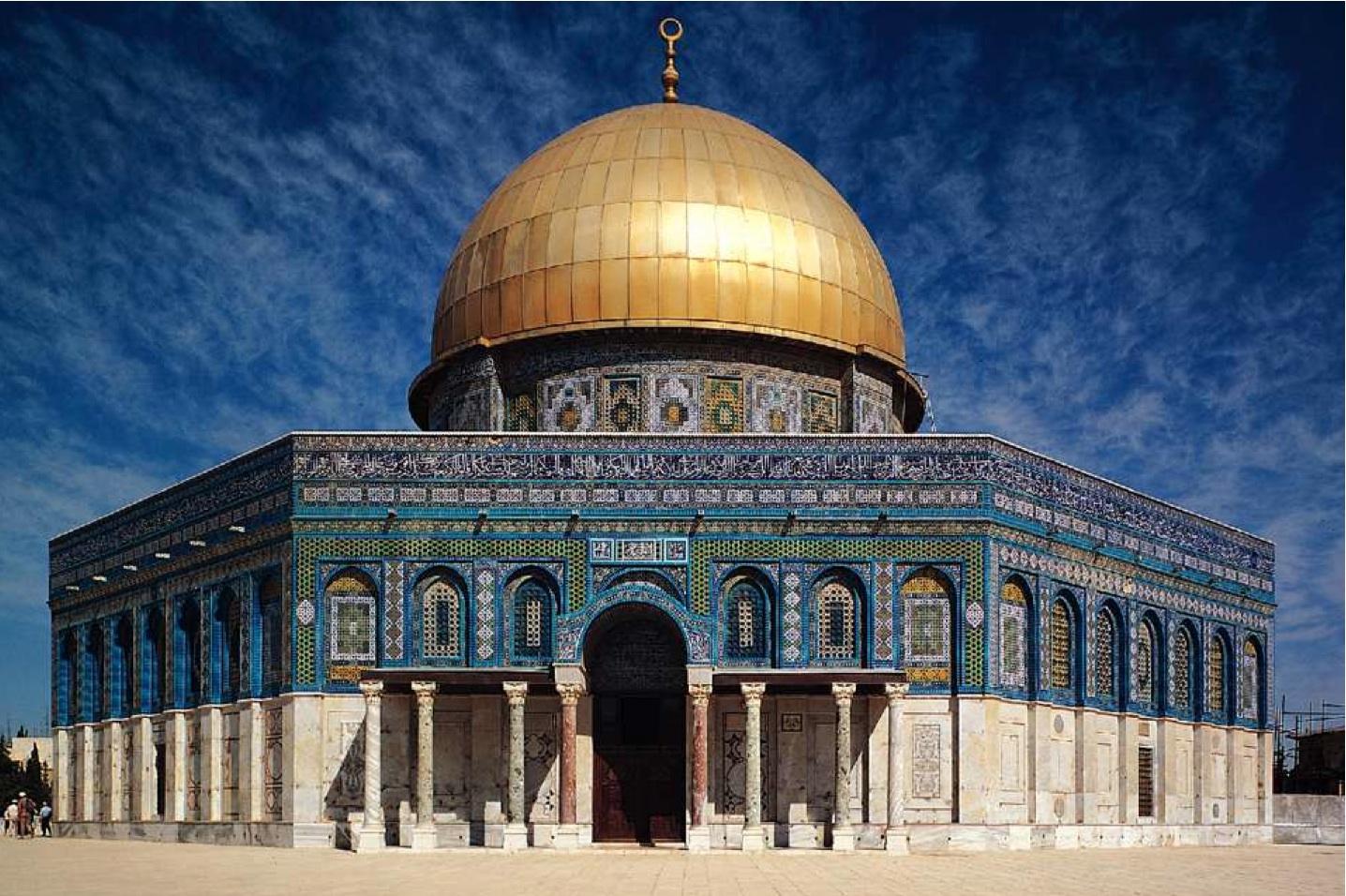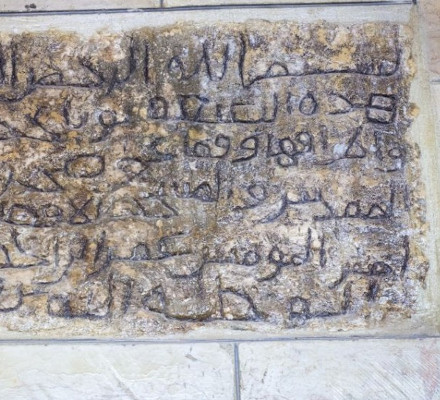The inscription bears witness to the fact that the Dome of the Rock structure was originally named “Bayt al Maqdis” referring to “The Holy Temple.” Link is to video and press release. This is big news because it is proof from within the Islamic faith that early Muslims knew that the Temple Mount was the site of the Jewish Temple and that they perceived the Dome of the Rock as a reestablishment of the earlier Temple.
Ancient Arabic inscription bears witness to the fact that the Dome of the Rock structure was originally named ‘Bayt al Maqdis’ referring to “The Holy Temple.”
A team of archaeologists revealed the existence of a 1000-year-old text, dated to the beginning of the Islamic era, which indicates that the Muslims perceived the Dome of the Rock as a reestablishment of the earlier Jewish Temple. They referred to it as “Bayt al-maqdis” in the inscription, which derives from the biblical Hebrew terminology as ‘Beit Hamikdash’, known as the Hebrew reference to the Holy Temple.
This unique find is located in the central mosque at the village of Nuba, next to the city of Hebron. Its significance lies in the fact that it is dated to the early Islamic Period, and it sheds light on the sanctification process of Jerusalem and especially of the Temple Mount to the Muslims.

The Nuba Inscription
The text on the rock quotes;
“In the name of Allah, the merciful God
This territory, Nuba, and all its boundaries
and its entire area, is an endowment to the Rock
of Bayt al-Maqdis and the al-Aqsa Mosque,
as it was dedicated by the Commander of the Faithful, ̒Umar iben al-Khattab
for the sake of Allah the Almighty”
The village of Nuba is mentioned in the inscription text as an endowment to the Rock of Bayt al-Maqdis [The Holy Temple] and the al-Aqsa Mosque. The text also notes that the one who did the dedication was ̒Umar iben al-Khattab, the Arab ruler who conquered Jerusalem from the Byzantines in 638 AD.
Assaf Avraham and Peretz Reuven, the archeologists who presented the existence of the inscription last week in the Conference on ‘New studies in the archaeology of Jerusalem and its region’ that was held at the Hebrew University in Jerusalem, pointed out that this text is, in fact, testimony that at least one of the names of the Dome of the Rock in the first centuries of Islam was “Bayt al-Maqdis” which preserves the Hebrew name “Beyt ha-Miqdash” (literally the “House of Sanctuary”). “The choice to use the name ‘Bayt al-Maqdis’ was not original,” says Assaf Avraham. “Using this name derived from the deep influence of Jewish tradition on the development of Islam in its earliest days.” In an article that was published in the Conference pamphlet, early evidence was presented in the form of quotes by Moslem believers who, it appears, entered and prayed within a place of worship at the Temple Mount, which was named “Bayt al-Maqdis” For example:
“I would regularly pray with Ibn-Dahar in Bayt al-Maqdis, when he entered, he used to remove his shoes.”
“Anyone who comes to Bayt al-Maqdiss only for the sake of praying inside it – is cleansed of all his sins.”
“I entered Bayt al-Maqdis and saw a man taking longer than usual for his bows.”
“The rock that is in Bayt al-Maqdis is the center of the entire universe.”
“Early Islamic literature shows that religious rituals were conducted within the Dome of the Rock at the beginning of the Islamic era” says Assaf; “These rituals were inspired by ancient traditions which took place within The Biblical Temple as is documented in the bible and in ancient Jewish literature.” An ancient Muslim source describes and stresses this point:
“Every Monday and Thursday morning the attendants enter the bath house to wash and purify themselves. They take off their clothes and put on a garment made of silk brocade embroidered with figures, and fasten tightly the girdle embellished with gold around their waists. And they rub the Rock over with perfume. Then the incense is put in censers of gold and silver. The gate-keepers lower the curtains so that the incense encircles the Rock entirely and the scent clings to it.”
These well documented and detailed procedures bear similarities to rituals that were practiced in the Jewish Temple, and were probably derived from them.
 The Nuba inscription implies that the building of the Dome of the Rock marks the re-construction of the biblical Holy Temple, in essence, one of the most significant acts in the early history of Islam, a new world view that asked to glorify Jerusalem’s position as the world’s religious center for Islam.
The Nuba inscription implies that the building of the Dome of the Rock marks the re-construction of the biblical Holy Temple, in essence, one of the most significant acts in the early history of Islam, a new world view that asked to glorify Jerusalem’s position as the world’s religious center for Islam.
When cross-referenced with other Muslim traditional literature of the time, it becomes clear that the Dome of the Rock’s structure was named Bayt Al-Maqdis in which prayers were conducted traditionally. It was the holiest structure within the Temple Mount and it was perceived as a renewed temple.
This unique revelation bears importance and relevance today considering UNESCO’s latest resolution which ignores the Jewish affinity to the Temple Mount.
Here is a link to the official article about the Nuba Inscription in Hebrew. Assaf and Peretz are working to create an English translation that will be published in the near future.



 The Nuba inscription implies that the building of the Dome of the Rock marks the re-construction of the biblical Holy Temple, in essence, one of the most significant acts in the early history of Islam, a new world view that asked to glorify Jerusalem’s position as the world’s religious center for Islam.
The Nuba inscription implies that the building of the Dome of the Rock marks the re-construction of the biblical Holy Temple, in essence, one of the most significant acts in the early history of Islam, a new world view that asked to glorify Jerusalem’s position as the world’s religious center for Islam.









Reblogged this on Kattukse Vrienden voor Israël.
so THERE, unesco!!!!!
Reblogged this on Anne's Opinions and commented:
In case we need another reminder (we don’t but UNESCO and the rest of its bigoted hypocritical fellow-travellers do), here is a glaring example of the Jewish history of the Temple Mount.
How much clearer proof tcan there be than a MUSLIM inscription describing the Temple Mount as a JEWISH site, calling it the site of “Bayt al-maqdis” – Bet Hamikdash in Hebrew, the Holy Temple.
Read the following blog post, and then share widely.
https://www.youtube.com/watch?v=HmsP5s29scE&t=3s